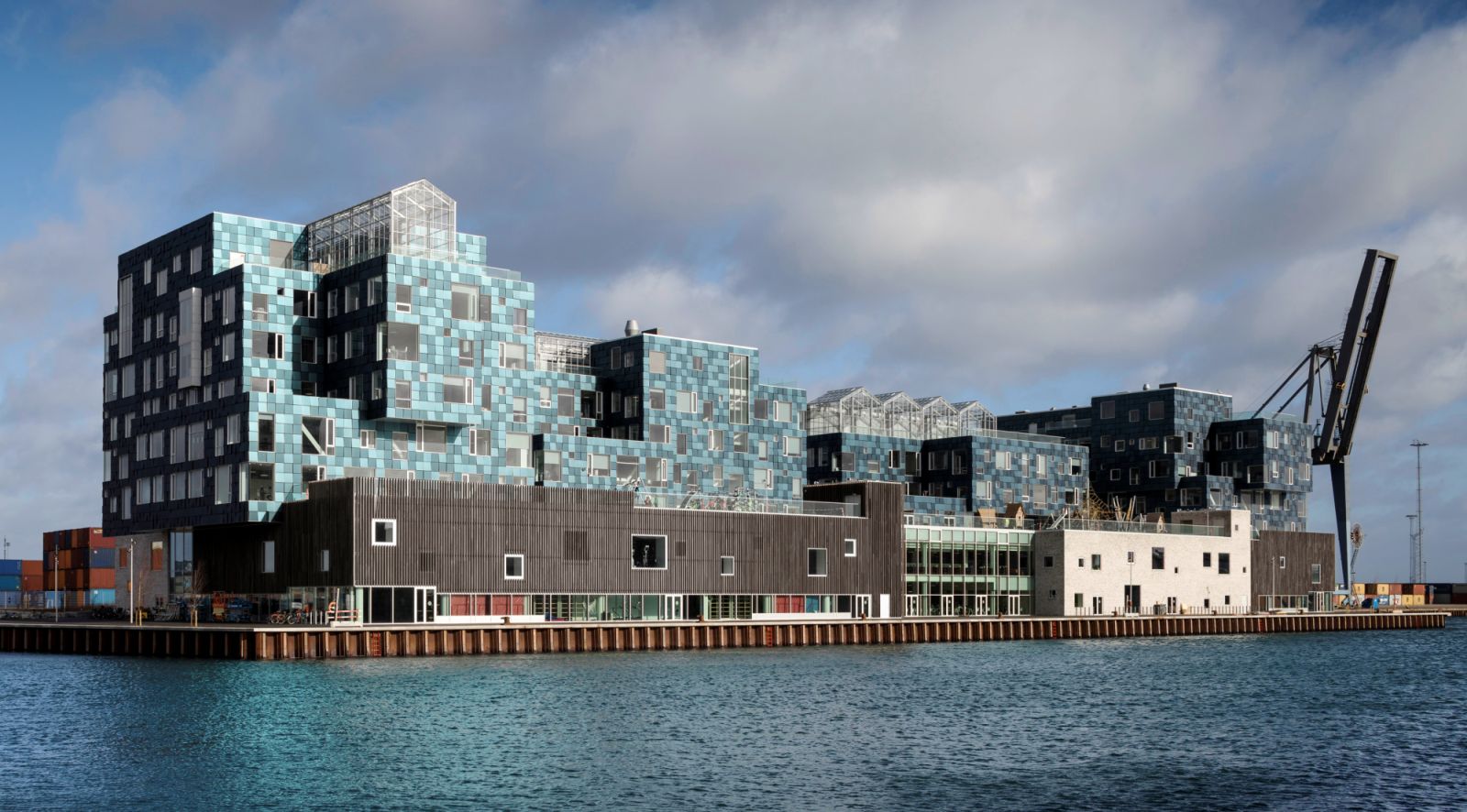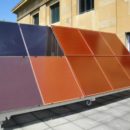
Copenhagen International School (DK) with its BIPV system developed for facade solutions. Photo credits: Adam Moerk.
Authors: C. Polo Lopez, P. Bonomo
SUPSI-ISAAC, Swiss BIPV Competence Centre
The full version of the article can be viewed at the following link: http://www.pv-enerate.ptb.de/16eng02-blog.html
The BIPV market in Europe is in a transition. The past decades of a slowly emerging BIPV market have been characterized by the original dominant value of BIPV: a building that communicates an image of sustainability and innovation. Payback time or returns on investment have not been the major parameters in the decision process for applying BIPV, as well as for conventional building products. The technological transfer of PV in the architecture field is changing design approaches and opening new challenges. Energy performance regulations are taking over as the main driving factor for the BIPV market. With the recast of the Energy Performance of Buildings Directive (EPDB 2010), which states that each new building should be made ‘nearly zero energy’ from 2020 onwards, high energy performance buildings are called to generate enough energy to balance their energy consumption, covered in a large extent by energy from renewable sources produced on-site.
To be attractive and competitive, photovoltaic solutions for the building sector, have to be “integrated” and “transformed” to fit the architect’s needs, also through a harmonized regulation. Today, a new reference standard defines the general requirements to be met by these types of products in the perspective that BIPV is a construction product. The industry already makes available a plenty of products for building application: multi-functionality, cost-effectiveness, mass customization and other paradigms are ensuring a growing penetration of the technology. Beyond functional and construction aspects, definitely BIPV is today one of the new fundamentals for contemporary architecture. BIPV is more and more a key driver for the PV market in Europe nowadays, as demonstrated in recent several pilot-projects, conducted in Switzerland and abroad, where it clearly emerges BIPV as a distinctive architectural solution.
BIPV market dynamics
The BIPV market is dynamic and many products appeared on the market within the last two years. New research efforts on BIPV nowadays focus on developing innovative performant, aesthetic and cost-effective solutions to provide the market with available products. Multi-functionality, cost effectiveness, mass customization and other paradigms are ensuring a growing penetration of the technology itself, but beyond functional and energy aspects. BIPV is slowly becoming part of the architectural concept. It is our expectation that in the next few years more prefabricated PV products, coloured PV products, semi-transparent PV products and lightweight PV products will have entered the market. Many attractive products are available, reliable and offered at a competitive price. Examples of aesthetically pleasing and affordable BIPV buildings can be found and are more and more entering the ordinary building stock.
To envision new markets concerning the integration of BIPV in the building environment, as construction element, the further requirements that should be addressed in next future are the durability, safety, reliability and maintenance together with low environmental impacts. This calls to an important bridge between building and PV specialisms.
Other key factors for the future development of the BIPV market, will be: 1) the value-chain of an integrated approach since early design process to support product and process innovation considering long-term new materials and solutions to achieve low production costs; 2) the right balance between customization and standardization without forgetting the importance of the “integration type” on energy performances; and finally; 3) a special focus on innovative design and more aesthetically attractive BIPV solutions that will allow some niche markets today definitely to take off.
New trends for BIPV technological systems
New manufacturing possibilities that are changing the PV component from an electrical device to an architectural tailored element represent one of the main BIPV technological trends, which are more and more opening the research field to the investigation of new operating conditions and energy behavior of BIPV systems. Different operating conditions from conventional PV as function of different building skin scenarios, colours or non-homogeneous surface treatments are just some examples. This document summarizes the main trends today leading new developments for the PV industry.
The process of product innovation in BIPV industry is today mainly linked to the integration of architectural image and construction technology in PV products. As stated in different studies, new technologies are constantly increasing the generation efficiency improving the return on the investments in BIPV where a high priority and challenge is to achieve cost competitiveness and similar prices to conventional building products, for large deployment in the construction sector. Innovative BIPV solutions are being developed, not only to ensure adequate performances satisfying functional and safety qualities, but mainly to achieve a valuable architectural design with solutions, as similar as possible, to other conventional building products.
Invisible “PV”, a technology ready for the market
In recent years, the transition of the BIPV market have been leaded by new emerging trends for BIPV based on different customization possibilities, such as the new design scenario of a hidden (coloured) or low-recognizable PV. Special treatments, colours or patterns applied to glass allow to mask solar cells and to mimic solar products with other similar products commonly used in construction, with not significant loss of electrical performance. This chromatic mimicry or technological mimicry applied to BIPV products is today possible thanks the mature design and qualification level for the building sector of solar glazing industry (e.g. safety glass, EU marking for CPR, mechanical and fire safety, etc.). In facade solutions, directly derived from already well-established building skin systems (e.g. curtain walls), the extra-cost of PV become less relevant. Many products are already being available but all implications (performances, proprieties, reliability, durability, lifetime, etc.) and PV energy outputs are still not well known and need to be further investigated.
Prefabricated, multi-functional and lightweight BIPV components for building skin
BIPV manufacturing companies are facing intense competition from emerging markets, stricter standardization and regulations as well as changing customer/architects behavior and requirements. Successful companies focus on product value rather than merely on product costs by using innovation technologies and effective new product development methods in search of competitive advantage with improved functionalities, added values and superior product performances.
In recent years, in the BIPV market unitized and pre-assembled elements to be directly used as roof or facade, represent a new trend that is being driven by a greater need for renovation of the real estate park and social housing renovation programs in several EU countries, and it is expected that prefab building further increasing the market potential in next years. Renovation process becomes faster and easier reducing labour cost. The objective is to reach greater product and process optimization towards mass-customization. In some available prefab systems, the whole process of design, manufacturing and implementation is performed industrially and it is possible customize colour, stratigraphy and thickness (e.g. insulation layer), dimensions, ratio transparency/opacity, indoor and outdoor final finishing, fixing and mounting system. In this case, as PV could be previously assembled and pre-wired in the entire building package the complexity and the cost could be reduced. In the same way, multifunctional/unitized “all-in-one” BIPV products, as polyvalent components able to satisfy more than a single technological requirement are gaining market.
Outlook
A review of available BIPV products and innovative BIPV solutions expected to enter the market in the next few years has been here summarized allowing to spot realistic scenarios of future market evolution. Plenty customization possibilities are today possible to make the next generation of PV products even more affordable, aesthetical attractive, efficient, versatile and multifunctional, customizable and in compliance with standards and regulations regarding technical and functional requirements for construction products. This optimization process, where technological innovation must advance along with cost-effectiveness and reliability, implies improving product and process such as manufacturing, installation and O&M, working directly with the construction and PV manufacturing industry. Along with a constant product and manufacturing innovation, also new approaches focusing on the process optimization (an example, from construction industry is BIM, Building information Modelling) that can support the challenge of a massive transfer of PV in the building market to more efficiently plan, design, construct, and manage buildings and infrastructures, but also to integrate the custom-made BIPV new modules in the manufacturing process efficiently.
In energy rating models, since now, BIPV systems are not yet considered with regard the possible interactions of the PV system with the building skin integration conditions that usually affect the PV power output and the energy behavior (e.g. roof and facade typologies, tilt and angle of slope, mounting and fixing elements, constructive package of the entire solution, transparency levels, unitized and prefabricated solutions or new materials, colours, textures or coatings, etc.). The interactions of the BIPV scenarios in the building skin, requires further detailed analysis to determine the main factors significantly influencing the energy yield.
Future research will have to investigate how these new approaches have to be considered in reference normative framework to properly analyze, test, validate and qualify BIPV products and systems since the BIPV non-conventional integration scenarios affect the PV energy behavior in different ways (electrical performance, operating conditions, temperatures, etc.). A first step would be to define reference scenarios for characterize and assess such effects, with the goal to optimize together aesthetics and energy aspects, by identifying the main requirements needed to describe and measure the performance of BIPV systems in building skin scenarios as well as the performance of special BIPV modules that are currently entering the market.





